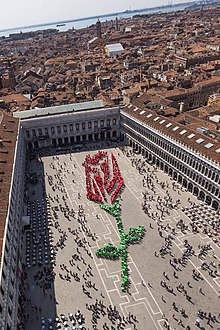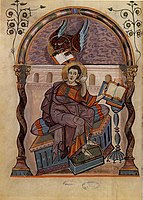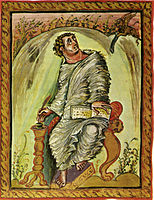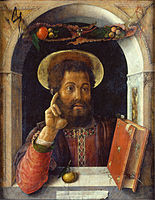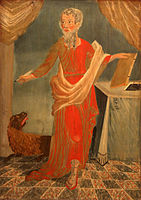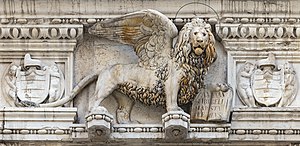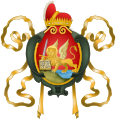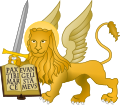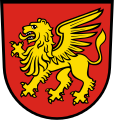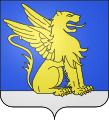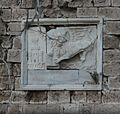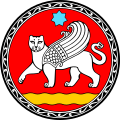If you like collectables then make sure to look at my other items as there are many more available. Look through them all!
Any issues or problems, please contact me before leaving feedback, as I will endeavour to resolve any issues amicably beforehand.
Mark the Evangelist
Mark the Evangelist | |
|---|---|
 Detail from a window in the parish church of SS Mary and Lambert, Stonham Aspal, Suffolk, with stained glass representing St Mark the Evangelist | |
| Evangelist, Martyr | |
| Born | c. 12 AD Cyrene, Pentapolis of North Africa, according to Coptic tradition[1] |
| Died | c. 68 AD (aged c. 56) Alexandria, Egypt, Roman Empire |
| Venerated in | All Christian churches that venerate saints |
| Major shrine | St Mark's Basilica (Venice) Saint Mark's Coptic Orthodox Cathedral (Alexandria) |
| Feast |
|
| Patronage | Barristers, Venice,[2] Egypt, Copts,[3] Mainar |
| Major works | Gospel of Mark (attributed) |
Mark the Evangelist (Latin: Marcus; Greek: Μᾶρκος, translit. Mârkos; Imperial Aramaic: ܡܪܩܘܣ, romanized: Marqōs; Ge'ez: ማርቆስ; Hebrew: מארק), also known as John Mark or Saint Mark, is the person who is traditionally ascribed to be the author of the Gospel of Mark. According to Church tradition, Mark founded the episcopal see of Alexandria, which was one of the five most important sees of early Christianity. His feast day is celebrated on April 25, and his symbol is the winged lion.[4]
Mark's identity[edit]
According to William Lane (1974), an "unbroken tradition" identifies Mark the Evangelist with John Mark,[5] and John Mark as the cousin of Barnabas.[6] However, Hippolytus of Rome in On the Seventy Apostles distinguishes Mark the Evangelist (2 Tim 4:11), John Mark (Acts 12:12, 25; 13:5, 13; 15:37), and Mark the cousin of Barnabas (Col 4:10; Phlm 1:24).[7] According to Hippolytus, they all belonged to the "Seventy Disciples" who were sent out by Jesus to disseminate the gospel (Luke 10:1ff.) in Judea.
According to Eusebius of Caesarea (Eccl. Hist. 2.9.1–4), Herod Agrippa I, in his first year of reign over the whole of Judea (AD 41), killed James, son of Zebedee and arrested Peter, planning to kill him after the Passover. Peter was saved miraculously by angels, and escaped out of the realm of Herod (Acts 12:1–19). Peter went to Antioch, then through Asia Minor (visiting the churches in Pontus, Galatia, Cappadocia, Asia, and Bithynia, as mentioned in 1 Peter 1:1), and arrived in Rome in the second year of Emperor Claudius (AD 42; Eusebius, Eccl, Hist. 2.14.6). Somewhere on the way, Peter encountered Mark and took him as travel companion and interpreter. Mark the Evangelist wrote down the sermons of Peter, thus composing the Gospel according to Mark (Eccl. Hist. 15–16), before he left for Alexandria in the third year of Claudius (AD 43).[8]
According to the Acts 15:39, Mark went to Cyprus with Barnabas after the Council of Jerusalem.
According to tradition, in AD 49, about 19 years after the Ascension of Jesus, Mark travelled to Alexandria and founded the Church of Alexandria. The Coptic Orthodox Church, the Greek Orthodox Church of Alexandria, and the Coptic Catholic Church all trace their origins to this original community.[9] Aspects of the Coptic liturgy can be traced back to Mark himself.[10] He became the first bishop of Alexandria and he is honored as the founder of Christianity in Africa.[11]
According to Eusebius (Eccl. Hist. 2.24.1), Mark was succeeded by Anianus as the bishop of Alexandria in the eighth year of Nero (62/63), probably, but not definitely, due to his coming death. Later Coptic tradition says that he was martyred in 68.[1][12][13][14][15]
Modern Bible scholars have concluded that the Gospel of Mark was written by an anonymous author rather than by Mark.[16][17][18][19][20] The four canonical gospels are anonymous and most researchers agree that none of them was written by eyewitnesses.[21][22][23][24] Some conservative researchers defend their traditional authorship, but for a variety of reasons most scholars have abandoned this theory or support it only tenuously.[25]
Biblical and traditional information[edit]
Evidence for Mark the Evangelist's authorship of the Gospel that bears his name originates with Papias (c. 60 – c. 130 AD).[26][27][28] Scholars of the Trinity Evangelical Divinity School are "almost certain" that Papias is referencing John Mark.[29] Modern mainstream Bible scholars find Papias's information difficult to interpret.[30]
The Coptic Church accords with identifying Mark the Evangelist with John Mark, as well as that he was one of the Seventy Disciples sent out by Christ (Luke 10:1), as Hippolytus confirmed.[31] Coptic tradition also holds that Mark the Evangelist hosted the disciples in his house after Jesus's death, that the resurrected Jesus Christ came to Mark's house (John 20), and that the Holy Spirit descended on the disciples at Pentecost in the same house.[31] Furthermore, Mark is also believed to have been among the servants at the Marriage at Cana who poured out the water that Jesus turned to wine (John 2:1–11).[31]
According to the Coptic tradition, Mark was born in Cyrene, a city in the Pentapolis of North Africa (now Libya). This tradition adds that Mark returned to Pentapolis later in life, after being sent by Paul to Colossae (Colossians 4:10; Philemon 24. Some, however, think these actually refer to Mark the Cousin of Barnabas), and serving with him in Rome (2 Tim 4:11); from Pentapolis he made his way to Alexandria.[32][33] When Mark returned to Alexandria, the pagans of the city resented his efforts to turn the Alexandrians away from the worship of their traditional gods.[34] In AD 68, they placed a rope around his neck and dragged him through the streets until he was dead.[34]
Veneration[edit]
The Feast of St Mark is observed on April 25 by the Catholic and Eastern Orthodox Churches. For those Churches still using the Julian Calendar, April 25 according to it aligns with May 8 on the Gregorian Calendar until the year 2099. The Coptic Orthodox Church observes the Feast of St Mark on Parmouti 30 according to the Coptic Calendar which always aligns with April 25 on the Julian Calendar or May 8 on the Gregorian Calendar.
Where John Mark is distinguished from Mark the Evangelist, John Mark is celebrated on September 27 (as in the Roman Martyrology) and Mark the Evangelist on April 25.
Mark is remembered in the Church of England and in much of the Anglican Communion, with a Festival on 25 April.[35]
In art[edit]
This section needs additional citations for verification. (April 2018) |
Mark the Evangelist is most often depicted writing or holding his gospel.[36] In Christian tradition, Mark the Evangelist is symbolized by a lion.[37]
Mark the Evangelist attributes are the lion in the desert; he can be depicted as a bishop on a throne decorated with lions; as a man helping Venetian sailors. He is often depicted holding a book with pax tibi Marce written on it or holding a palm and book. Other depictions of Mark show him as a man with a book or scroll, accompanied by a winged lion. The lion might also be associated with Jesus' Resurrection because lions were believed to sleep with open eyes, thus a comparison with Christ in his tomb, and Christ as king.
Mark the Evangelist can be depicted as a man with a halter around his neck and as rescuing Christian slaves from Saracens.
- Depictions of Mark the Evangelist
Major shrines[edit]
Lion of Saint Mark
The Lion of Saint Mark, representing Mark the Evangelist, pictured in the form of a winged lion, is an aspect of the Tetramorph. On the pinnacle of St Mark's Cathedral he is depicted as holding a Bible, and surmounting a golden lion which is the symbol of the city of Venice and formerly of the Venetian Republic.
It is also found in the symbol of the Greek Orthodox Patriarchate of Alexandria. It appears in both merchant and military naval flags of the Italian Republic. The Lion of Saint Mark is also the symbol of the award of the Venice Film Festival, the "Golden Lion", and of the insurance company Assicurazioni Generali.
Symbolism[edit]
The representation as a lion is derived from Mark's description of John the Baptist as "...The voice of the one who cries in the wilderness: Prepare Ye the way of the Lord, make straight his paths",[1] which artists compared to a roaring lion.[2] The wings come from Ezekiel 1:10 and the application of the prophet's vision of four winged creatures to the evangelists.[3] These appear again in Revelation 4:7.
A second connection of Mark and lions comes from a tale recounted by Severus Ebn-El-Mokafa: "Once a lion and lioness appeared to John Mark and his father Arostalis while they were traveling in Jordan. The father was very scared and begged his son to escape, while he awaited his fate. John Mark assured his father that Jesus Christ would save them and began to pray. The two beasts fell dead and as a result of this miracle, the father believed in Christ."[2]
In some depictions the lion rests his front paws on the ground, often in cities with rivers or in ones close to water, indicating the Venetian balanced power on land and sea.
Mark and Venice[edit]
Venetian tradition states that when Mark was traveling through Europe, he arrived at a lagoon in Venice, whereby an angel appeared to him and said, "Pax tibi Marce, evangelista meus. Hic requiescet corpus tuum." ("Peace be with thee, O Mark, my evangelist. Here thy body will rest.").[4] This tradition was used as justification by Rustico da Torcello and Bon da Malamocco[5] in 828[6] for stealing the remains of Mark from his grave in Alexandria,[7] and moving them to Venice, where they were eventually interred in the Basilica of St. Mark.[8]
A fifteen-foot bronze statue of a lion stands atop a column of Egyptian granite in St. Mark's Square. It was brought to the lagoon during the 12th century, and remained there until Napoleon moved it to Paris. Returned in 1815, it fell and was rebuilt. It was moved from its pedestal only at the end of the 1800s for restoration and during the Second World War for safekeeping. The Lion underwent careful restoration work in the 1990s.[9] Restorers believe its body is roughly 2,300 years old.[10]
There are also lions carved in relief on the façade of the Doge's Palace, and at the Scuola Grande di San Marco[10] The coats of arms of Popes Pius X, John XXIII, and John Paul I contain the Lion of St. Mark in recognition of their previous positions as Patriarchs of Venice.
It is also visible in several places in the Giuliano-Dalmata area of Rome (including the church of San Marco Evangelista in Agro Laurentino), which was settled by refugees from the Julian March (formerly Venetian territory) after the Second World War.
The name of the Lion of Saint Mark in the Venetian language is Leòn de San Marco.
Depictions[edit]
The Venetian lion appears in two distinct forms. One is as a winged animal resting on water, to symbolise dominance over the seas, holding St. Mark's Gospel under a paw. These animals can be seen all around the Mediterranean, usually on top of a classical stone column.[11] The other form is known as the lion "in moleca", in the form of a crab. Here the lion is depicted full-faced with its wings circled around the head and resembling the claws of a crustacean. It is emerging from water, so that the lion "in moleca" is associated with the lagoon and the city, whereas the standing winged lion is thought to be more associated with Venetian territory around the Mediterranean.[11]
The Latin words engraved on the book are Pax Tibi Marce Evangelista Meus, which means Peace unto you, Mark, my Evangelist.
Other elements often included in depictions of the lion include a halo over his head, a book, or a sword in its paws.
In British heraldry, "Lion of St. Mark" is commonly used to refer to all winged lions. These figures are depicted in arms as both passant and, more commonly, sejant, and also appear as supporters. The heraldist Arthur Charles Fox-Davies, however, defined the true Lion of St. Mark as being one used specifically within religious badges to signify the saint, and to have a halo.[12]

